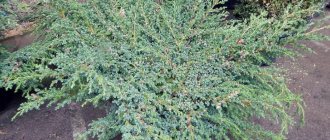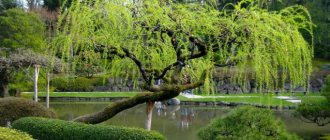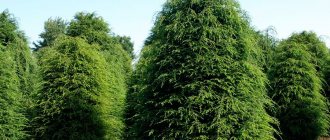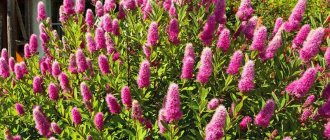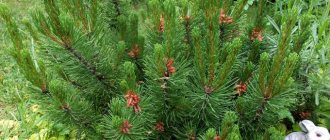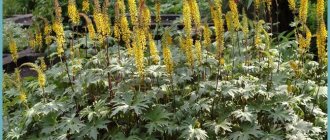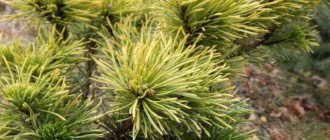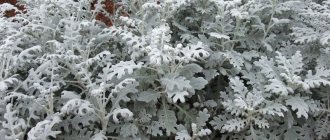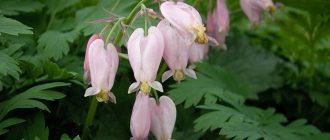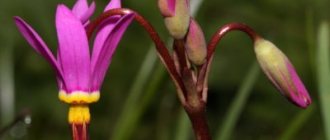Bushes and trees
0
389
Article rating
Kira Stoletova
The peculiarity of coniferous crops is their decorativeness and aesthetics, year-round preservation of the green crown, variety of forms, unpretentiousness to the type of soil and care. Even in the smallest area, such shrubs will look picturesque and organic, decorating the surrounding area with their rich color of the ground part. Thuja Tiny Tim is a very popular breed for landscaping areas, flower beds and lawns.
Thuja occidentalis Tiny Tim
Brief information about the variety
- Color : crown is dark green, woody parts are reddish or grayish-brown.
- Height : in the 10th year of life it grows up to 30 cm, and an adult plant reaches 1 m;
- Crown width : up to 1-1.5 m;
- In what regions does it grow : from the climate of Southern Siberia to the tropics of Sochi;
- Features of planting : requires mandatory filling with a mixture of earth, sand and peat in equal proportions, followed by abundant watering and sprinkling the soil near the trunk with peat and sawdust to a layer of 5 cm.
- Immunity : has frost resistance and unpretentiousness to living conditions, as well as climatic fluctuations;
- Lifespan : Perennial evergreen.
How to plant thuja with seeds
Growing thuja from seeds is advisable if you plan to install long borders or hedges at your dacha. For such a design you will need a lot of planting material. To independently obtain thuja seedlings from seeds, it will take from 3 to 5 years. However, it should be taken into account that new trees may not reproduce the varietal characteristics of the mother plant.
Thuja seeds ripen in cones. They are collected at the very beginning of autumn until they open, after which they are kept warm for a couple of days so that the seeds fall out naturally.
Thuja seeds should be sown immediately after collection. After 3 months of warm storage, their germination rate will drop significantly.
The best option is to sow before winter. The seedlings will grow stronger, and there will be little hassle with them. In autumn, thuja seeds can be sown directly into the garden bed or into a buried box. The second method is more convenient, since in the spring the container with seedlings can be easily moved to the greenhouse.
To sow thuja you will need the following soil composition:
- turf or garden soil - 1 part;
- peat – 2 parts;
- sand – 0.5 parts.
The mixture is poured into the box, leaving 2-3 cm from the edge. Grooves about 1 cm deep are cut at a distance of 5-6 cm from each other. Thuja seeds are evenly distributed along the entire length of the grooves, filled in, then the soil is pressed down with a plank. You can mulch the crops with 2-3 cm of peat chips and cover them with non-woven material (from animals). The box must be installed on the site in a place where direct sunlight does not reach.
In the spring, about 3 weeks after the soil warms up, the thuja seeds will sprout. The shoots will look like thin branches of juniper or spruce, but later (after 2-3 months) real scaly “legs” will appear.
Sowing at home
You can sow thuja in the fall and at home. With this option, the seeds undergo stratification on the bottom shelf of the refrigerator in a container with wet sand or sawdust. After 2 months (in February), they are removed and sown in a box filled with drainage (2 cm from the bottom) and soil for conifers. Sowing is done according to the 1*1cm pattern in a checkerboard pattern. When planting at home, thuja seeds are not covered with soil, but lightly pressed into it, moistened with a spray bottle and covered with film.
When the roots begin to appear, they are slowly sprinkled with nutritious soil and sprayed with water. After a month, the cover is removed. Seedlings must be regularly sprayed with water. It is recommended to plant home-grown thujas in the ground only in the third year. In the summer they can be placed outside, and with the onset of cold weather they can be taken indoors.
Description of the plant
Western Thuja Tiny Tim (Thuja occidentalis Tiny Tim) has excellent winter hardiness and can be grown even in the regions of Southern Siberia.
By planting it as a border for flower beds with other flowers and plants, the shrub will protect from dust and many pests.
In landscape design it is used as an element that emphasizes the beauty of ground cover and tall flowers, enlivens the edges of the lawn, the foot of alpine hills, and borders garden paths.
The variety was bred back in 1955. Today it is presented in the most advanced forms, has an excellent appearance and frost resistance.
IMPORTANT: It is distinguished by its light-loving nature, undemandingness to the composition of the soil, as well as its level of humidity, although it grows best on fertile loams that are sufficiently moist and fresh.
The dwarf breed grows slowly. By the age of 10, the plant reaches 0.3 m. The height of an adult specimen can vary from 0.5 to 1 m.
The crown grows to 1-1.5 m, with dense branches planted in a heap, which create a spherical shape.
The hard parts of the trunk are grayish-brown or reddish in color, with flaking scales, growing from the root collar.
Reproduction methods
This species can be propagated in two ways:
- Seed . Experienced gardeners recommend leaving seeds under the snow for the winter. As practice shows, after this they grow faster. They can also be sown in spring.
- Cuttings . Lignified or semi-lignified cuttings are suitable for this method. Before planting, they should be treated with Heteroauxin. Planting material is most often immediately planted in a greenhouse, but it also takes root well in open areas.
Did you know? Bioenergetics specialists claim that thuja growing near the house can relieve nervous tension in the family and helps restrain negative emotions.
With its spherical shape, Tiny Tim constantly attracts attention. Having planted such a plant on your site, get ready for the fact that all your guests will be constantly interested in this shrub. It will definitely make your garden more beautiful.
The necessary conditions
Thuja grows both in sunny areas and in partial shade.
- In the first case, it requires more careful care, since it may suffer from frost followed by drying out, as well as from temperature fluctuations. IN
- In full shade, slow growth is observed, the bush is depressed, its crown is loose and sparse.
It is also not advisable to plant in open, windy areas. It is necessary to arrange crushed stone drainage provided that groundwater is close.
IMPORTANT: To prevent plantings from becoming thickened during the first planting, gardeners must observe the frequency of places for each plant, the distance between which should not be less than 0.5-1 m (crowns of an adult thuja).
Pests
Good care will help keep the plant healthy
- Spider mite - sucks juices from young organs, which leads to their drying out. To exterminate the parasite, acaricides are used - Actellik or Aktaru.
- Decis is used for scale insects. In the fight against aphids, at the initial stage, the crown is irrigated with a solution of ash and soap, infusion of tobacco or garlic. At an advanced stage, they are sprayed with insecticides (Fundazol or Karate).
- Perithroid drugs - Moskitol Antiklesch, Tornado or Fumitox - will help destroy the thuja moth. Treatment is carried out twice with an interval of 8 days.
- Another parasite of the thuja Tiny Tim is the click beetle. It feeds on small conifer roots. To exterminate it, it is necessary: every autumn to dig up and deoxidize the soil, add sand or vermiculite drainage under the digging and spray with Bauzudin, Zemlin or Kapkan.
- Bark beetles prefer to eat young wood. By gnawing holes in the bark, they can lead to the rapid death of the tree - within a month. It is difficult to save such a plant, so it is better to carry out preventive measures in a timely manner - treatment with Clipper in early spring and early autumn.
To avoid infection with diseases and parasites, it is worth using healthy material for planting, following the planting pattern, watering, fertilizing and irrigating on time for the purpose of prevention with appropriate fungicides or insecticides.
Landing
The tree needs sunlight
To plant this plant, you must first decide on the propagation method (cuttings or seeds), and also select the right seedling.
In addition, there are certain planting rules, according to which the hedge or composition will look attractive and the plants will develop as nature intended.
Selection of seedlings
In order for the thuja to turn out beautiful, healthy and complete, you need to choose the right seedling for planting. A small sprout is cut off from the mother bush, which slightly captures the crown.
The procedure is carried out in early spring, when the plant begins a new growth cycle (it will absorb moisture well and distribute it to all cells and leaves).
Acceleration of the development of the rhizome system occurs by placing the plant in a container with clean water for about 10 hours, adding a special preparation.
IMPORTANT: before transplanting, you need to place the prepared seedlings in separate containers filled with sand, peat and soil.
It is best to keep them in greenhouse conditions with moderate watering. This will ensure consistently high temperature and humidity. As soon as several fresh shoots appear, the special film can be removed, but planting in open ground is recommended only after a year of keeping in the greenhouse.
Preparing the site
The plant in the container is taken out to the site. In order not to damage the root system and to safely remove the seedling, you need to water it abundantly immediately before planting with clean water at room temperature.
The depth of the pit should be twice the height of the container. If the aquifer is located close, then it is necessary to prepare special drainage: first fill in a layer of crushed stone and sand (about 0.25 m).
IMPORTANT: The soil for the plant is prepared as a mixture of sand, peat and soil in equal proportions.
Landing technology
In order for the plant to take root and develop better, you need to add a small amount of special fertilizers for conifers.
Experts recommend planting thuja using the transshipment method: carefully remove it from a technical container with “native” soil.
The voids that form between the earthen lump and the pit cavity must not be filled with earth; only prepared soil composition can be added.
IMPORTANT: Mandatory watering with settled and warm water is required immediately after planting, followed by mulching with crushed wood bark or peat in the tree trunk area.
Landing Features
Like other representatives of the Cypress family, Thuja Tiny Tim prefers to grow in a shaded place where there are no drafts and groundwater close to the surface.
A site near fences, outbuildings, trees with a spreading crown and tall bushes is suitable.
The optimal distance in such a neighborhood is at least 1 m, otherwise there will be competition for moisture, space and nutrients.
Selection of seedlings
When choosing a seedling for growing on a plot, preference should be given to specimens 2-3 years old.
It is desirable that they have a closed root system, since such plants quickly and successfully adapt to a new location.
Main selection criteria:
- the length of the above-ground part is at least 30 cm;
- root system without signs of rot, mold and disease;
- crown of uniform green color, without yellow or black spots;
- shoots are intact, flexible, without breaks.
For cultivation, they buy plants in an earthen coma wrapped in burlap or bushes planted in containers.
Planting dates vary depending on the region - in the south you can plant both in the spring (April-May) and in the fall - in early September.
In areas with changeable weather and harsh winters, it is better to give preference to spring planting. This way the seedlings will have time to take root, take root over the summer and prepare for the upcoming winter.
Preparing the site
Thuja does not like drafts
Tiny Tim grows well on loamy soil with good drainage and slightly acidic reaction. Before planting, the bed is sprinkled with sand or vermiculite at the rate of 2-3 buckets per 1 m².
If you plan to plant on sandy loam, you should add a little clay - 15-20 kg for the same area.
To the acidified area, where the pH level exceeds 6 units, additionally add dolomite flour, calcite, slaked lime or chalk - 350 kg. After this, deep digging and leveling are carried out.
Planting holes are dug two weeks before the planned planting of seedlings so that the soil has time to settle. Their sizes depend on the dimensions of the earthen clod - approximately 70x80x80 cm. When growing in groups, maintain a distance between seedlings - at least 1 m and 1.5 m in a row.
Landing technique
Drainage is poured into the bottom of the hole, which will prevent moisture stagnation after watering. Half a bucket of a mixture of crushed stone, pebbles, screenings and broken bricks is enough.
Next, the hole is half filled with a nutrient composition of turf, leaf soil, peat and sand in the proportion 2:2:1:1.
To increase soil fertility, you can add 100 g each of superphosphate and potassium nitrate.
Sprinkle the top with a thin layer of garden soil, then lower the ball of roots, cover it, compact it and water it abundantly at the rate of 10 liters per seedling.
When planting, it is important to follow one rule - you need to plant the plants so that the root collar is 4-5 cm above the soil surface. Otherwise, the tree will grow and develop slowly, over time the lower part of the trunk will begin to rot and it will die.
Care
The plant is quite unpretentious to care for, but in the first year, immediately after planting in open soil, increased and careful care is required.
Then the rhizome is not yet sufficiently strengthened and consolidated in the soil, so there is a possibility of wilting or a decrease in the intensity of development of the shrub.
Watering
When watering, do not allow moisture to stagnate.
It is often necessary to moisten the soil immediately after planting: add 10 liters of warm, settled water every day. Continue for 2 years.
The regularity and volume of watering is reduced only in case of cloudy or rainy weather: complete watering should be done no more than 1-2 times a month.
Be sure to provide additional watering of the crown from a garden hose on hot and sultry days. Then drying out of the needles will be minimized.
For mature shrubs, it is necessary to add water to the area around the trunk twice a month (about 10-15 liters). To avoid stagnation of moisture, which provokes rotting of the rhizome, immediately after watering, loosen around the trunk of the bush.
IMPORTANT: You can reduce up to 10 liters of fluid per week starting from the 3rd year of thuja’s life.
Feeding
In the spring it is necessary to add substances with a high content of phosphorus and nitrogen. Nitroammophoska copes best with this task.
This event will protect the root system from drying out.
In the autumn, potassium fertilizers are added to the soil around the bush.
Mulching and loosening the soil
It is recommended to loosen the soil close to the trunk of the bush and with a depth of up to 0.1 m. This will prevent accidental damage to the roots, which come closer to the surface.
In order for the soil to maintain the required level of moisture for a long time, mulching should be done using crushed wood chips or peat, which are placed around the thuja trunk in a good thick layer of 5 cm.
Haircut and trimming
After wintering, areas with dried, frozen or fungal infections may form on the branches. The affected parts should definitely be cut off with the arrival of spring warmth.
The Tini Tim variety does not require additional crown formation. If the plant is part of a composition or hedge, you can cut off up to 1/3 of the length of the branches.
IMPORTANT: It is better to significantly reduce the length during the annual sanitary haircut.
Preparing for winter
Despite the excellent frost resistance of the variety, the Tini Tim shrub requires preparation for the winter period. This will reduce the amount of damage to the branches and keep the plant looking beautiful. Young, recently planted bushes also need special protection.
IMPORTANT: The maximum temperature that the bush can withstand is up to -40°C.
Before the onset of frost, the crown is covered with burlap, agrofibre or other material.
To prevent burns during the first rays of sunlight, it is important to provide additional shade.
Remove the “covers” from the bushes after the soil has completely thawed. The ideal period is a calm, cloudy day. This will ensure minimal or no damage.
Features of care
During the dry period, young seedlings need regular watering - 2 times a week, 2 buckets for each bush. In addition, you should spray the needles with water from a spray bottle. For a month after planting, thuja Tini Tim is watered once every 7 days. 1 bucket per bush. After watering, loosen the soil shallowly. To prevent moisture from evaporating too quickly, the ground is mulched with pine chips.
Sanitary pruning is done in the spring. There is no need for a shaping haircut - this variety forms a compact round “hairstyle” on its own. Mature trees are not afraid of frost. Withstands temperatures down to -40 degrees without shelter. Young thujas need protection from winter cold and spring burns - they are wrapped in soft burlap or agrofibre.
In the spring, apply nitroammophoska (30 grams per square meter) or any complex fertilizers. In October they are fed with potassium supplements. If fungal damage is detected, the bush is treated with fungicides. Preventive spraying is carried out with 1% Bordeaux mixture in April. When thuja aphids appear, the plant is treated with insecticides. Any treatments are carried out twice with an interval of 10 days.
Reproduction
The plant can propagate by cuttings or seeds. The first event is simpler.
Cuttings
Thuja is easy to propagate using cuttings
- A small sprout is cut off and placed in a container with liquid, where a small amount of rhizome growth accelerator is added. Keep for about 10 hours.
- Then they are transplanted into a greenhouse container.
- After the first few fresh shoots appear, the film is removed, but the conditions remain greenhouse for up to 1 year.
- Only after this they land in open areas.
- Care for the young bush is intensive for another 3 years, and then standard.
Seeds
Material for planting is collected independently or purchased in appropriate stores.
- The ripened cones are thoroughly dried.
- All seeds are removed only after the cones are opened.
- It is recommended to plant seeds in the soil before the first snow covers appear, at the beginning of winter.
- With the arrival of early spring, fertilizers are applied to the planting sites, abundant watering is carried out and covered with film material. This will ensure reliable maintenance of the desired temperature and humidity.
- Covering materials are removed from the moment the first shoots appear, which should be regularly weeded, cleaned of weeds, and organic and mineral fertilizers applied. Be sure to water.
- I do the picking only after 3 years of cultivation, followed by aging for another 2 years in containers.
IMPORTANT: Only 5-year-old seedlings are suitable for planting in open soil.
Reproduction of thuja Tiny Tim
Thuja Tiny Tim is propagated by seed and cuttings. The description of the process of seed propagation of Tiny Tim thuja seems simple only at first glance. In fact, this is a very long procedure, which is not surprising, because the growth rate of thuja is very low. This type of propagation is used if it is necessary to completely preserve all the qualities of the mother plant.
Cones are collected from mature bushes in mid-autumn, laid out on natural fabric and kept there until completely dry. When the scales have opened, you can remove the seeds from them.
Cones can only be collected in autumn
Ready seeds are immediately planted in open ground. This occurs after the first autumn frosts and the establishment of light snow cover. In spring, mineral fertilizers are applied to the soil, and future plants are regularly watered. If spring is delayed, then after the snow has melted, it is worth covering the bed with the seeds with film. It is removed immediately after the first shoots appear. Weeding and watering are carried out immediately. Picking will be required no earlier than 3 years after emergence. This happens because the western thuja grows too slowly, and young plants are very unstable to environmental conditions. Growing all together, they cope better with bad weather and their survival rate is higher.
Important! It is also possible to grow seedlings at home. In this case, they must remain warm until they reach 5 years of age.
For the winter they are taken to a bright, cool room.
Propagation by cuttings
Cuttings are harvested in mid-March. They are cut with a sharp knife, their length should be about 14 cm. First, the cut branches are placed in a glass with a root solution. After 12 hours, the planting material is placed in prepared boxes with soil. It is watered, and the cuttings are covered with glass jars or cut plastic bottles. Such shelter provides the necessary level of humidity and temperature. The cover is removed only after new shoots begin to appear on the branches.
Thuja cuttings need to be cut with sharp pruning shears
Diseases and pests
Thuja rhizomes often get burns due to the abundant addition of fertilizers to the soil. This leads to drying out of the bush and yellowing of its crown.
Also, the appearance of a yellowish tint can be caused by thuja aphids. Most often it reproduces and lives on the lower part of the bush. Parasitic microorganisms are eliminated with Karbofos.
There is also a moth. When it attacks, the color of the crown becomes brown, with the partial death of some sections of the branches. A drug that contains pyrethroids helps fight. But it must be applied only in the second half of July.
IMPORTANT: Putrid odors of rhizomes appear as a result of excess moisture in the soil. This not only spoils the plant, but also provokes the development of harmful late blight.
To prevent the development of pathogenic microorganisms, regularly loosen the soil around the trunk, and also apply fungicides.
The emerging disease requires immediate burning of the entire bush with mandatory replacement of the soil so that the infection does not spread to other plants.
Diseases
This variety of thuja is highly resistant to disease; infection is possible only if the rules of planting, care and maintenance are not followed.
The most dangerous diseases include:
- Rust. A fungal disease that damages the entire aerial part - the shoots, trunk, needles are covered with reddish-brown shapeless growths. Over time, the affected areas begin to dry out, the needles and young growth turn yellow and crumble. Fungicides are used in treatment - first, the damaged organs are removed, then the crown and trunk area are irrigated with a solution of copper sulfate, Skor, Hom or Ridomil Gold.
- Brown Schutte. Another very dangerous fungal disease, the peak of development of which occurs at the beginning of summer. Signs of damage are the massive appearance of black dots on the surface of needles and shoots at the end of August. The shrub begins to go bald, shedding yellowed needles en masse. In wrestling they use Ridomil Gold, Skor, Hom or Bordeaux mixture.
- Drying of shoots. Thujas that grow in weed thickets and crowded conditions are susceptible to this disease. On the tree you can see how the young growth begins to turn yellow and later dry out along with the needles. The treatment consists of two stages - first, the damaged branches are removed, then the crown is irrigated twice with an interval of 7 days with a solution of copper sulfate.
Use in landscape design
The use of thuja Tiny Tees in landscape design is very wide - from single plantings and presentation as the main element of the composition, to the creation of hedges or borders for paths.
Rockeries, flower beds, alpine slides, flower beds, and rock gardens decorated with thuja also look beautiful.
Often these plants are perfect as hedges that separate the functional areas of the site - they create an interesting look and a calm atmosphere when planted near benches, hammocks or gazebos.
IMPORTANT: Mounds of pebbles or sand enhance the color of the thuja.
Conifers can be planted along city roads and highways: they are not only unpretentious to external climatic conditions, but also tolerate gas pollution, dust deposits and other pollution well.
Shrubs are extremely popular in various public and private facilities for landscaping. If there are artificial reservoirs, then such plants, due to their high moisture-loving properties, thrive there.
Caring for thuja seedlings
In the first season, young animals must be fed every two weeks with complex mineral fertilizer. You can take a universal one for conifers: “Mortar” or “Agricola”. Over the summer, young thujas will grow to 7-8 cm. Street-sown seedlings remain overwintering in the same place, covered with special material or a hut made of spruce branches.
In the second year, the grown young thuja (street) can be planted in a special bed, where they will grow to a “marketable” appearance. The place should be chosen in light partial shade. The soil is dug up using the bayonet of a shovel, and the following fertilizers are applied (per 1 m2):
- a bucket of humus;
- 40 g nitroammophoska;
- 250-300 g of ash.
Thuja seedlings are planted according to a 30*30 cm pattern. The root collar must be at soil level, otherwise the sprout will dry out. Plantings should be watered as the soil dries; fertilizing is carried out once every 3 weeks.
In the third year, young thujas reach approximately 50 cm in height; they can already be transplanted to a permanent place.
For a thuja hedge to look impressive, its crowns must have a uniform structure. When sowing seeds, the quality of seedlings may vary, so when planting them nearby in a permanent place, you should select similar specimens.
Reviews
Gardeners note the unpretentiousness and frost resistance of Tini Tim, as well as the ability of the variety to maintain the color of the crown all year round.
However, caring for thuja in the first years after planting in open soil is a slightly labor-intensive and scrupulous process, and therefore requires certain skills and knowledge.
Many people like the versatility of the plant for landscape design, since green dense spherical bushes fit perfectly into any composition.
The culture can be used both as a main decorative element and in mass group plantings.

